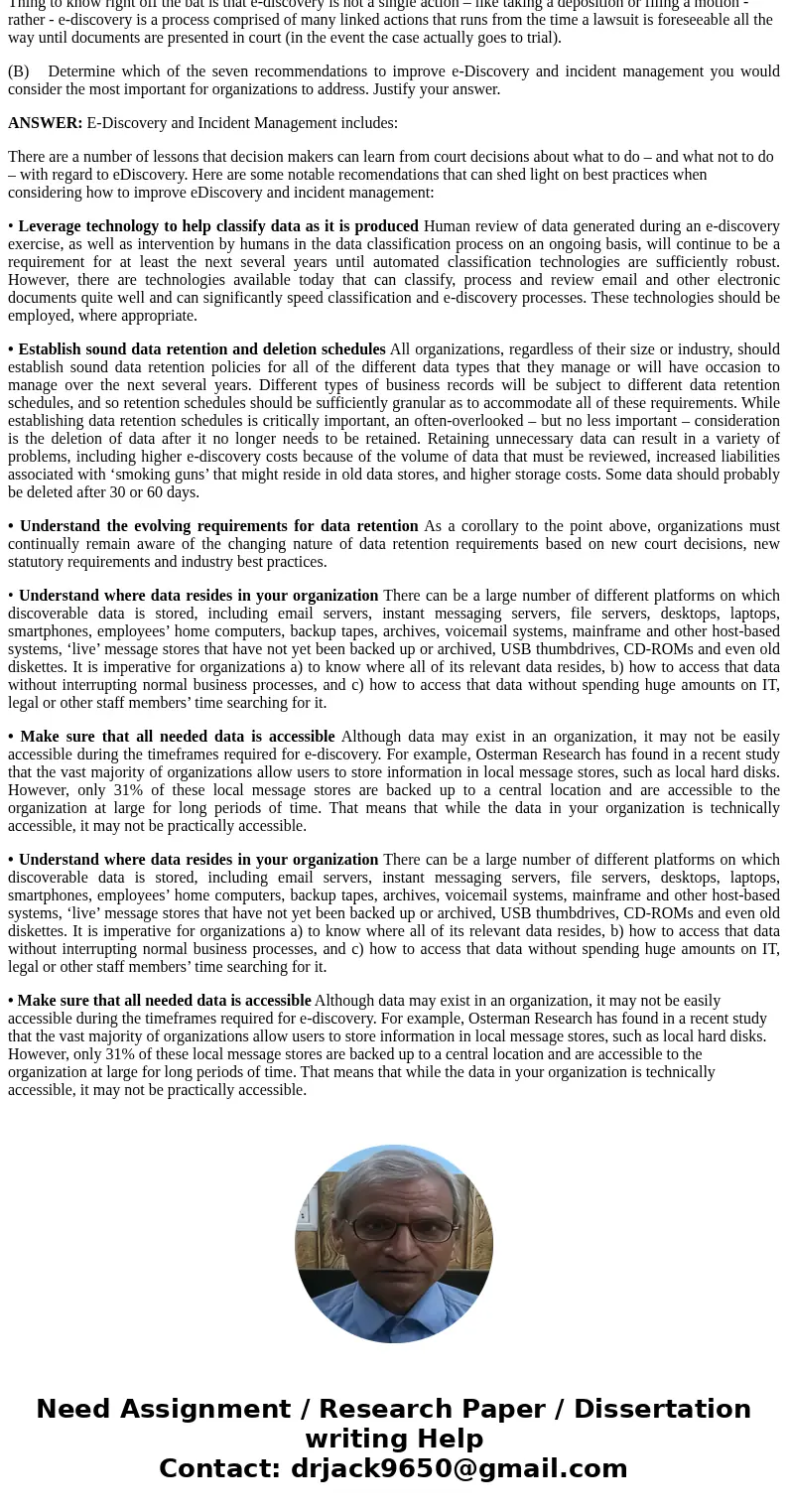eDiscovery in Action Please respond to the following A Expla
\"e-Discovery in Action\" Please respond to the following:
(A) Explain the top three reasons why you believe organizations may be unprepared to manage incidents effectively and in a timely fashion. Provide real-world examples to support your chosen reasons.
(B) Determine which of the seven recommendations to improve e-Discovery and incident management you would consider the most important for organizations to address. Justify your answer.
Solution
\"e-Discovery in Action\" Please respond to the following:
ANSWER:
Electronic discovery or e-Discovery is a procedure by which parties in a legal matter, such as litigation, preserve, collect, review, and exchange information in electronic formats - known as electronically stored information (ESI) - for the purpose of using it as evidence in the matter.
three important reasons with examples:
• eDiscovery is an important issue and is becoming more serious over time, but most corporate decision makers believe they are not as well prepared for it as they should be.
For example Most organizations have at least partially addressed eDiscovery issues focused on email, but a growing number of data types and venues are complicating the problems of eDiscovery and content management in general. eDiscovery rules and requirements continue to evolve and are placing additionaldemands on decision makers to manage eDiscovery properly.
For example The transition from DOS to Windows opened computing to everyone. Similarly, e-discovery is struggling to design the transformative killer apps or platform that will render e-discovery as intuitive and seamless as operating an iPhone and allow genuine e-discovery to inform all litigation matters, disputes, and investigations.
For example In Exterro\'s 2015 \"Federal Judges Survey on E-Discovery Best Practices and Trends,\" not a single one of the 22 responding judges said they fully agreed with the statement that the typical attorney possesses the subject matter knowledge (legal and technical) required to effectively counsel clients on e-discovery matters. If that\'s not a wakeup call, we don\'t know what is.
Research shows that:
• Only 60% of the respondents’ organizations had comprehensive records retention schedules in 2007 that include electronic records, up from 51% in 1999. Only 49% of organizations have a formal email policy focused on retention practices for email, up from 45% in 1999.
• Only 55% of organizations have records retention schedules for email, instant messages, blogs, collaboration tools and other types of communication; and only 43% have such schedules for electronic documents.
• Only 14% of organizations always follow their retention schedules, while another 50% generally do so.
• Only 16% of organizations has a formal policy focused only retention of voicemail, 15% have such a policy for instant messages and only 7% have a retention policy for blog content.
• Only 56% of organizations have a formal plan that will allow them to respond to discovery requests for their records.
Thing to know right off the bat is that e-discovery is not a single action – like taking a deposition or filing a motion - rather - e-discovery is a process comprised of many linked actions that runs from the time a lawsuit is foreseeable all the way until documents are presented in court (in the event the case actually goes to trial).
(B) Determine which of the seven recommendations to improve e-Discovery and incident management you would consider the most important for organizations to address. Justify your answer.
ANSWER: E-Discovery and Incident Management includes:
There are a number of lessons that decision makers can learn from court decisions about what to do – and what not to do – with regard to eDiscovery. Here are some notable recomendations that can shed light on best practices when considering how to improve eDiscovery and incident management:
• Leverage technology to help classify data as it is produced Human review of data generated during an e-discovery exercise, as well as intervention by humans in the data classification process on an ongoing basis, will continue to be a requirement for at least the next several years until automated classification technologies are sufficiently robust. However, there are technologies available today that can classify, process and review email and other electronic documents quite well and can significantly speed classification and e-discovery processes. These technologies should be employed, where appropriate.
• Establish sound data retention and deletion schedules All organizations, regardless of their size or industry, should establish sound data retention policies for all of the different data types that they manage or will have occasion to manage over the next several years. Different types of business records will be subject to different data retention schedules, and so retention schedules should be sufficiently granular as to accommodate all of these requirements. While establishing data retention schedules is critically important, an often-overlooked – but no less important – consideration is the deletion of data after it no longer needs to be retained. Retaining unnecessary data can result in a variety of problems, including higher e-discovery costs because of the volume of data that must be reviewed, increased liabilities associated with ‘smoking guns’ that might reside in old data stores, and higher storage costs. Some data should probably be deleted after 30 or 60 days.
• Understand the evolving requirements for data retention As a corollary to the point above, organizations must continually remain aware of the changing nature of data retention requirements based on new court decisions, new statutory requirements and industry best practices.
• Understand where data resides in your organization There can be a large number of different platforms on which discoverable data is stored, including email servers, instant messaging servers, file servers, desktops, laptops, smartphones, employees’ home computers, backup tapes, archives, voicemail systems, mainframe and other host-based systems, ‘live’ message stores that have not yet been backed up or archived, USB thumbdrives, CD-ROMs and even old diskettes. It is imperative for organizations a) to know where all of its relevant data resides, b) how to access that data without interrupting normal business processes, and c) how to access that data without spending huge amounts on IT, legal or other staff members’ time searching for it.
• Make sure that all needed data is accessible Although data may exist in an organization, it may not be easily accessible during the timeframes required for e-discovery. For example, Osterman Research has found in a recent study that the vast majority of organizations allow users to store information in local message stores, such as local hard disks. However, only 31% of these local message stores are backed up to a central location and are accessible to the organization at large for long periods of time. That means that while the data in your organization is technically accessible, it may not be practically accessible.
• Understand where data resides in your organization There can be a large number of different platforms on which discoverable data is stored, including email servers, instant messaging servers, file servers, desktops, laptops, smartphones, employees’ home computers, backup tapes, archives, voicemail systems, mainframe and other host-based systems, ‘live’ message stores that have not yet been backed up or archived, USB thumbdrives, CD-ROMs and even old diskettes. It is imperative for organizations a) to know where all of its relevant data resides, b) how to access that data without interrupting normal business processes, and c) how to access that data without spending huge amounts on IT, legal or other staff members’ time searching for it.
• Make sure that all needed data is accessible Although data may exist in an organization, it may not be easily accessible during the timeframes required for e-discovery. For example, Osterman Research has found in a recent study that the vast majority of organizations allow users to store information in local message stores, such as local hard disks. However, only 31% of these local message stores are backed up to a central location and are accessible to the organization at large for long periods of time. That means that while the data in your organization is technically accessible, it may not be practically accessible.


 Homework Sourse
Homework Sourse